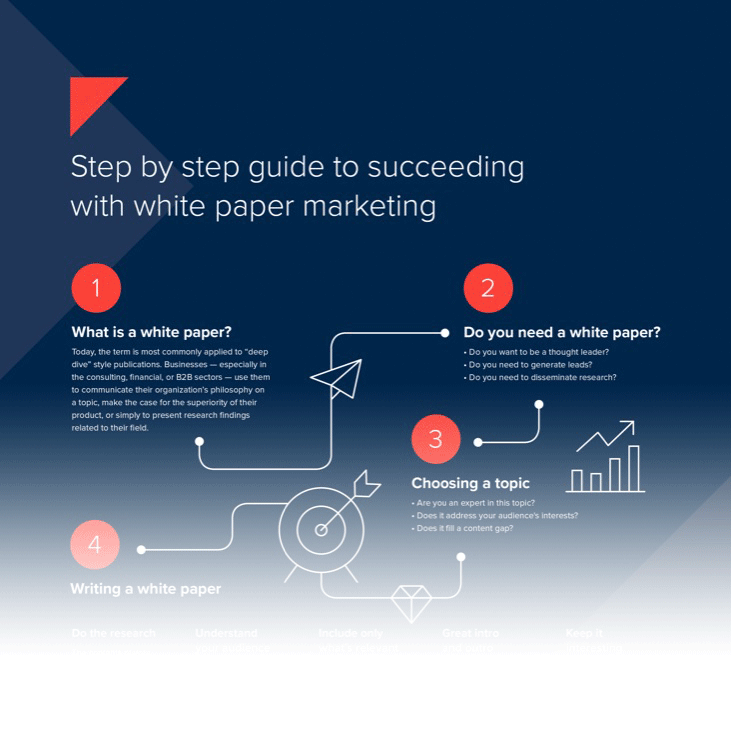White paper writing is often perceived as the Holy Grail of freelance writing due to its unique characteristics and requirements. Unlike other types of writing, white papers demand extensive research, deep subject knowledge, and an ability to present complex information clearly and concisely.
A white paper is a comprehensive document that presents a complex issue, offers a solution, and provides guidance to readers. They are commonly used in industries such as technology, finance, and healthcare, where companies rely on well-researched and expertly crafted content to showcase their products or services.
As a freelance writer, mastering the art of white paper writing can open doors to lucrative projects and establish credibility in various industries. Therefore, understanding and unraveling the secrets of white paper writing can truly be the key to success in the freelance writing world. In this blog, we will unveil the secrets of white paper writing and explore why it is considered the holy grail of freelance writing.
Whether you are an aspiring freelance writer or a business owner looking to create impactful content, this guide will provide you with valuable insights and tips to excel in white paper writing.

The Key Elements of a Successful White Paper.
These documents act as authoritative guides or reports that aim to educate readers about a specific topic or offer solutions to a particular problem. The secrets to successful white paper writing lie in capturing the reader’s attention from the beginning, presenting well-researched information, organizing it effectively, and suggesting actionable steps for the readers.
Achieving success with a white paper requires careful consideration of the following key elements:
- Clear and concise language: A successful white paper should be written using simple language, avoiding jargon and technical terms that may confuse the reader. It should explain complex concepts in a way that is easily understood.
- Well-defined problem statement: The white paper should start by clearly identifying the problem or challenge that it aims to address. It should provide background information and context to help the reader understand the significance of the problem.
- Thorough research and analysis: The white paper should include comprehensive research on the topic, including data, statistics, and expert opinions. It should analyze the problem from various angles and present a well-rounded perspective.
- Solution-oriented approach: A successful white paper should not just focus on outlining the problem; it should also propose practical solutions or recommendations to address the problem. These solutions should be well-supported by evidence and logic.
- Structure and organization: The white paper should have a logical structure that guides the reader through the content. It should have clear headings and subheadings, along with a table of contents and an executive summary for easy navigation.
- Credibility and authority: It is important to establish credibility in a white paper by including the credentials and expertise of the author or the organization behind the paper. It should also include references or citations to external sources to support the claims and arguments made in the paper.
- Visual aids and illustrations: The use of visual aids such as graphs, charts, or diagrams can help simplify complex data or concepts and make them easier to understand. Visual elements should be used strategically and not overwhelm the text.
- Target audience consideration: A successful white paper should be tailored to the specific needs and interests of the target audience. It should consider the level of expertise and prior knowledge of the readers and present the information accordingly.
- Engaging and persuasive writing: The white paper should be engaging and hold the reader’s attention throughout. It should use persuasive language to motivate the reader to take action or consider the proposed solutions.
- Proper formatting and editing: The white paper should be well-formatted, with consistent font styles, sizes, and spacing. It should also be thoroughly edited for grammar, spelling, and punctuation errors to ensure a high level of professionalism.
.
Conducting Thorough Research for Your White Paper.
In today’s fast-paced world, the demand for well-researched and informative white papers is higher than ever. However, conducting thorough research for a white paper comes with its own set of challenges. One of the primary challenges is the abundance of information available, making it difficult to sift through and identify credible sources.
Moreover, the ever-changing landscape of industries requires white paper authors to stay updated with the latest trends, regulations, and technological advancements. When conducting research for your white paper, it is crucial to follow a thorough process to ensure the accuracy and reliability of your sources.
You should begin by defining your research question and clearly articulating the problem or topic you are addressing in your white paper. This will serve as a guide throughout your research process and help you focus on relevant information. Gather general background information and knowledge on the subject through reliable sources such as textbooks, reputable websites, and academic journals that will provide you with a foundation for deeper research and help you understand the context of your topic.
Develop a search strategy by determining the keywords and phrases that are most relevant to your research question. Use these terms to conduct searches in online databases, libraries, and search engines. Be flexible and try various combinations to retrieve the most relevant information.
You should assess the credibility, relevance, and authority of each source you encounter by considering the author’s credentials, the publication or website’s reputation, and whether the information is reliable and unbiased. Academic journals, government reports, and reputable news outlets are generally more reliable sources.

Structuring Your White Paper Effectively.
An effective white paper follows a structured approach consisting of an attention-grabbing introduction, a clear problem statement, a thorough analysis, a well-argued solution or recommendation, and a persuasive conclusion. By organizing your white paper using these components, you can ensure that your message is cohesive, logical, and compelling, making it easier for readers to understand and engage with your ideas. Here, we will discuss five essential components for structuring a white paper
- Introduction:
The introduction should grab the reader’s attention and provide a concise overview of the topic. Start with a hook or a unique proposition related to the problem or issue you are addressing. This section should also include background information to set the context of your white paper. Clearly state the purpose, objectives, and scope of your document. Lastly, conclude the introduction by presenting an outline of the subsequent sections, giving readers a glimpse of what to expect.
- Problem Statement:
In this section, clearly define the problem or challenge you aim to address in your white paper. Present supporting evidence, such as statistics, research findings, or real-life examples, to illustrate the problem’s significance. Use a logical and persuasive approach to convince the reader that the problem needs attention. Succinctly explain the consequences or impact of not addressing the problem, highlighting why your solution or recommendation is necessary.
- Analysis:
The analysis section is the heart of your white paper. Provide an objective analysis of the problem, its causes, and factors that contribute to it. Break down complex concepts into understandable terms, using diagrams or visual aids if necessary. Discuss the different perspectives related to the problem, including opposing viewpoints. Use relevant data, research, and case studies to support your analysis. Make sure to address potential objections and counterarguments.
- Solution or Recommendation:
In this section, propose a solution or recommendation to solve the problem outlined in the previous sections. Clearly explain how your solution addresses the root causes and offers long-term benefits. Provide step-by-step implementation strategies, estimated costs, and expected outcomes. Justify your solution with credible evidence and logical reasoning and compare it to existing alternatives or approaches. If applicable, include success stories or testimonials from individuals or organizations that have implemented similar solutions.
- Conclusion:
The conclusion wraps up your white paper by summarizing the main points and restating the importance of the problem and your proposed solution. Emphasize the benefits and potential impact of adopting your recommendation. Avoid introducing new information in this section. Instead, encourage readers to take action, whether it is further research, implementation, or seeking expert advice. End with a compelling call to action to engage your audience.
Writing in a Clear and Concise Manner.
Writing a white paper can be a daunting task. Because these documents are the gold standard of thought leadership that sets your brand apart from the competition, you want to make sure your content is clear and concise while still conveying valuable information. It’s easy to get bogged down in jargon and industry terms, leaving your audience confused and uninterested. Writing clearly and concisely is an essential requirement for effective white paper writing.
Writing clearly and concisely is an essential requirement for effective white paper writing. Concise writing helps you to organize your ideas and streamline your overall writing process, while also making it easier for your readers to understand your message. But where do you start? How do you make sure your content is clear and concise while still conveying valuable information?
Concise writing is clear and does not contain needless or ambiguous words or phrases. Adding extra words or phrases to your work might make it appear more professional or scholarly. However, often, this will confuse your writing and make your arguments more difficult for the reader to grasp.
Readers and audiences like simple writing. Concise phrases and paragraphs will capture your reader’s attention and assist them in focusing on your key argument. More succinct writing will also assist you, the writer, in organizing your ideas and streamlining the whole writing process. Clear writing, free of wordiness and bloated sentence structure, elevates works of artistic writing, persuasive writing, business writing, and academic writing alike.
To successfully communicate your thoughts, choose language that is clear and concise. Charts, graphs, diagrams, and infographics are examples of visual features that can improve your white paper’s readability and comprehension. When necessary, use pertinent images to help explain difficult ideas or data.

Designing an Eye-catching White Paper Layout.
Designing an eye-catching white paper layout can greatly enhance the effectiveness of your document and make it more appealing to readers. A well-designed layout not only improves the visual appeal of the white paper, but also helps to communicate information in a clear and organized manner. When designing the layout, it is important to consider the overall structure of the white paper.
Start by creating a table of contents that clearly outlines the different sections and subsections. This will make it easier for readers to navigate the document and find the information they are looking for. Next, choose a clean and professional font for the body text. Stick to a maximum of two fonts throughout the entire document to maintain consistency. Avoid using overly decorative fonts that may be difficult to read.
To make your white paper visually appealing, incorporate relevant images, graphs, and charts to support the information presented. Use high-quality images that are properly formatted and resized. Ensure that any charts or graphs are clearly labeled and easy to understand.
In terms of overall document formatting, make use of headers, subheaders, and bullet points to break up the text and make it easier to scan. This helps readers quickly identify key points and main sections. Consistently apply these formatting elements throughout the document for a cohesive and professional look.
Finally, ensure that the white paper layout is optimized for both print and digital viewing. Consider the appropriate page size and orientation (e.g. A4, landscape) based on the intended distribution method. Also, make sure the layout is responsive for online viewing, allowing for easy reading on different devices and screen sizes.

Promoting Your White Paper to Attract Clients.
Promoting your white paper is a crucial step in attracting new clients and establishing your credibility in the industry. A white paper is an authoritative document that showcases your expertise and provides valuable insights to your target audience. However, simply creating a white paper is not enough. You need to develop a comprehensive promotion strategy to ensure that your target clients are aware of its existence and are compelled to engage with it.
One of the most effective ways to promote your white paper is through digital marketing channels. Begin by optimizing your website to showcase and promote the white paper prominently. Create a dedicated landing page that highlights the key benefits and takeaways from the white paper. Use compelling visuals, engaging copy, and clear calls to action to encourage visitors to download it.
Utilize email marketing campaigns to reach out to your existing client base and prospects. Create personalized emails that highlight the unique value proposition of your white paper and how it can address the pain points of your target audience. Leverage automation tools to schedule follow-up emails and nurture leads throughout their buyer’s journey.
In addition to email marketing, leverage social media platforms to amplify the reach of your white paper. Create visually appealing posts that provide teasers or snippets from the white paper and include a direct link to download it. Encourage your followers to share the content with their networks to increase visibility.
Remember, promoting your white paper is an ongoing process. Continuously monitor the performance of your promotions and make adjustments as needed. Regularly analyze key metrics such as downloads, website traffic, and conversion rates to measure the success of your promotion strategy. With a comprehensive and targeted approach, you can effectively attract clients and position yourself as a thought leader in your industry.
The Benefits of White Paper Writing in Enhancing Your Freelance Career.
White paper writing can be a valuable tool in enhancing your freelance career. As a freelance professional, establishing yourself as an expert in your field is crucial for attracting new clients and securing high-paying projects. White paper writing offers a unique opportunity to showcase your knowledge, skills, and expertise to your target audience.
One of the key benefits of white paper writing is the ability to demonstrate thought leadership. By providing valuable insights, analysis, and solutions to industry-specific problems, you can position yourself as an authority in your field. This can help you gain credibility and trust from potential clients, leading to more opportunities for freelance work.
Another advantage of white paper writing is the potential for networking and collaboration. When you publish a white paper, it can attract the attention of industry experts, influencers, and other professionals. This can open doors to new partnerships, collaborations, and speaking engagements, which can further enhance your freelance career.
Furthermore, white papers can serve as powerful marketing tools. By producing high-quality content that addresses the pain points of your target audience, you can attract potential clients and demonstrate the value you can bring to their projects. White papers can be used as lead magnets on your website, shared on social media, or distributed through industry publications, reaching a wider audience and increasing your visibility as a freelancer.
White paper writing also provides an opportunity for continuous learning and professional development. As you research and write white papers on various topics, you deepen your knowledge and expertise in your field. This ongoing learning process can keep you up-to-date with the latest industry trends and advancements, making you a more valuable asset to your clients.
.

Conclusion: Unleashing Your Potential as a Freelance Writer Through White Paper Writing.
White paper writing can be a powerful tool for freelance writers to unleash their potential and establish themselves as experts in their field. They provide a unique opportunity to showcase your knowledge, skills, and expertise to potential clients and employers.
By mastering the art of white paper writing, freelance writers can position themselves as authoritative voices in their industry and attract high-paying clients who are seeking thought leadership and insightful analysis. The ability to effectively communicate complex ideas and present well-researched information in a concise and compelling manner is crucial in the world of white papers.
To fully harness the potential of white paper writing, it is important for freelance writers to continuously refine their craft. This includes staying updated on industry trends, conducting extensive research, and honing their writing skills for maximum clarity and impact. Building a portfolio of well-crafted white papers will not only showcase your abilities, but also serve as a testament to your expertise in the field.
Furthermore, freelancers should also make use of networking opportunities to connect with potential clients, industry experts, and peers. Collaborating on white paper projects, attending industry conferences and workshops, and leveraging social media platforms can help expand your professional network and open doors for new opportunities.
In the ever-evolving landscape of freelance writing, white paper writing can set you apart from the competition and provide a steady stream of high-quality clients. By investing time and effort into mastering this specialized form of writing, freelance writers can unleash their potential and build a successful and fulfilling career in the industry. So, embrace the power of white papers and watch your freelance writing career soar to new heights.


